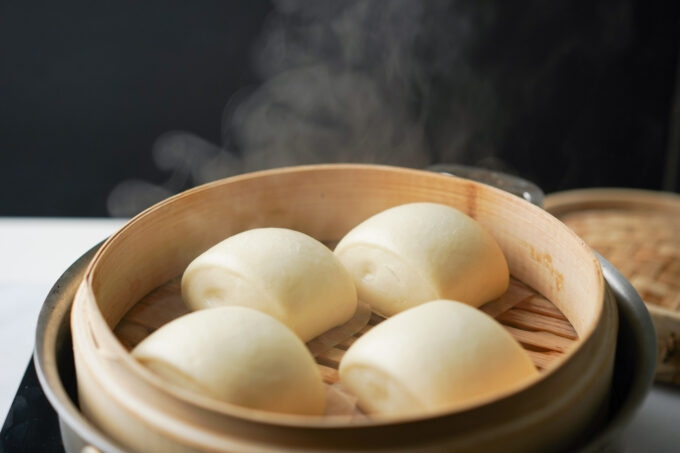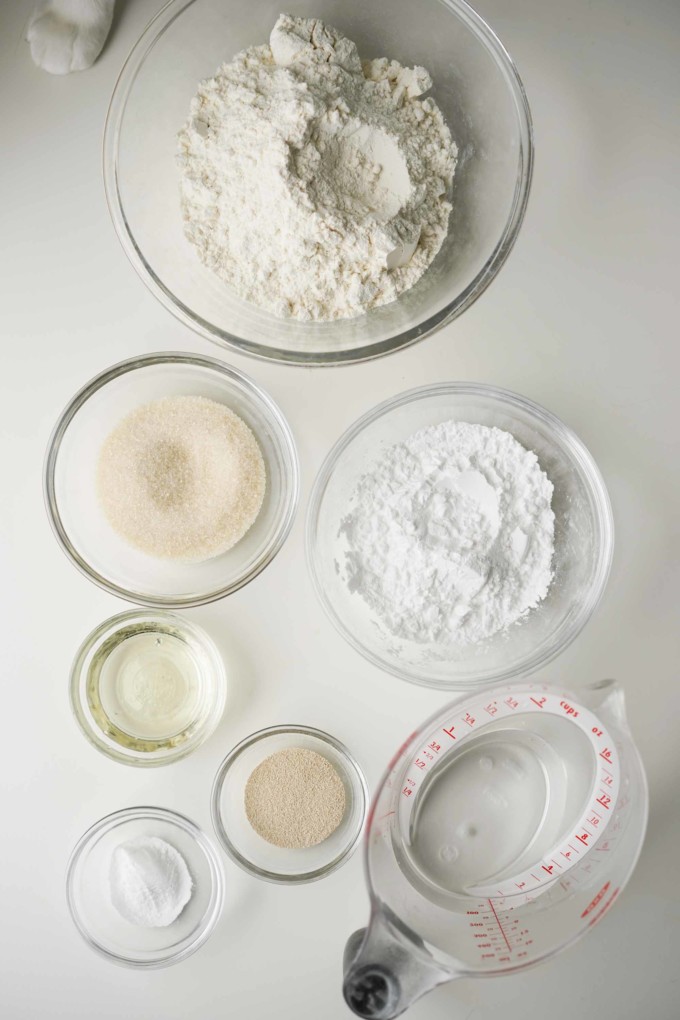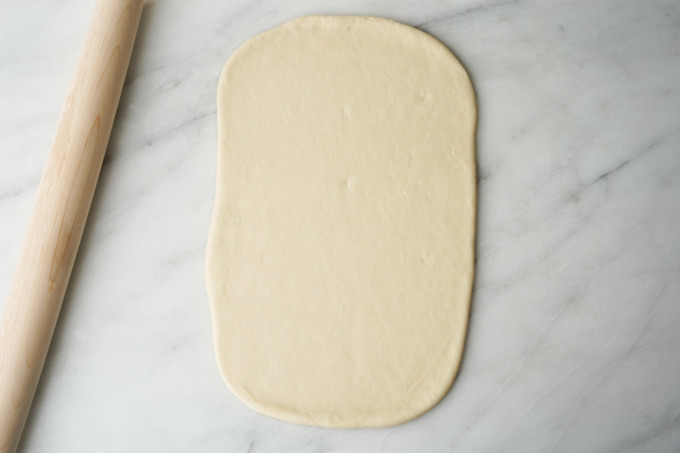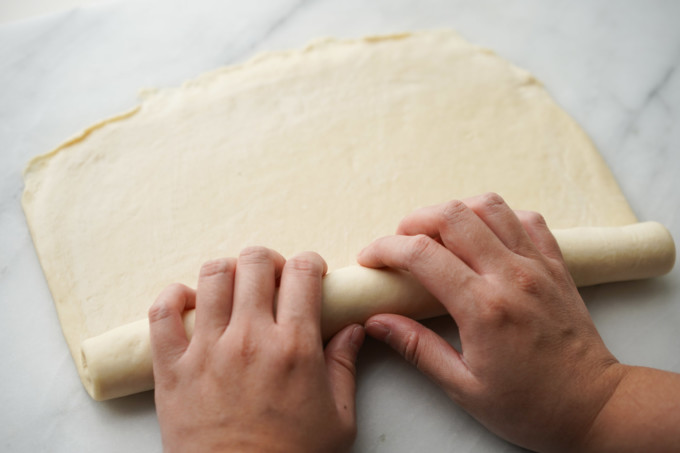Fluffy, ultra-soft, and slightly sweet–these mantou are more than just a simple side of sweet steamed buns. This easy mantou recipe will teach you how to get hot and freshly steamed Chinese bread for your next breakfast or meal.

What is mantou?
Mantou, or Chinese steamed buns, were thought to have originated from the Qin State during the Zhou Dynasty in China circa 300 BCE. Its origin is often connected to the story of Zhuge Liang, which is where these Asian buns got their name mántóu (meaning “barbarian heads” in Mandarin).
These round or semi circle-shaped, sweet steamed buns are a food staple in Northern China these days, along with rice and noodles. These steamed buns might look slightly familiar because they also look like baozi or bao for short. The main difference between mantou and baozi is that the latter has a sweet or savory filling added, like char siu bao.

I’ve mainly eaten two types of mantou (both steamed and fried varieties) at local Chinese restaurants (some of my favorites are Happy Family and Capital Seafood). Since mantou has a very simple flavor, they typically come with condensed milk as a dipping sauce.
As a food staple in Chinese culture, you can also find them premade in the refrigerator and frozen aisles of your local Chinese grocery stores like 99 Ranch. Some brands I’ve seen are Chimei, I-Mei, and Ley Grand. You can find so many different types of mantou these days: plain milk, sweetened, whole wheat, taro, chocolate, and even matcha.
Types of flour for mantou vs bao

My recipe for mantou is similar to my char siu bao recipe except it uses wheat starch (this is NOT the same as all-purpose flour, but an entirely different ingredient) instead of cornstarch and it has a different process in how to handle the dough. If you see mantou in restaurants, you might be familiar with its ultra-white coloring that comes from using white bleached flour and often wheat starch.
The addition of wheat starch can give the mantou a super soft and bouncy texture due to its very low gluten properties. If you cannot find wheat starch nearby, you can also use cornstarch, but your steamed buns might differ in color and softness. Wheat starch is used in many Chinese recipes like cheung fun, steamed bao buns, and char siu bao.
You can find wheat starch at your local 99 Ranch or Chinese grocery stores, but you can also buy wheat starch online (they might be more expensive than in-store prices).
It’s important to note that if you do not use white bleached flour and wheat starch, you may not get the ultra white color of traditional steamed rolls. Some people say to add vinegar to the water as you steam, but this does not work. For my mantou, I use unbleached flour so the color is more cream-colored than pure white.
Tips for making Chinese steamed buns

After making batches and batches of mantou, here are some tips I’ve learned along the way:
- Use a scale to weigh out all your ingredients for a fool-proof recipe!
- Use your pointer finger to press down on the top edge of the dough to flatten it. This thinned out edge will help you seal the log of dough after rolling.
- Brush on some water before rolling to get the dough to stick to itself and seal better.
- Use the palms of your hands to roll out the log of dough. This will help combine all the layers and keep them from spreading too much.
- Allow the dough to sit in the steamer over warm water and proof for 20 minutes, but not more than that, or it will overproof and wilt after it steams. Proofing will give you soft and fluffy Chinese bread texture.
- After it’s done steaming, move the steamer off the heat and let it rest without removing the lid for at least 4 minutes. Resting lets the temperature inside the steamer come down and doesn’t shock the mantou. Sometimes when you remove the lid too quickly after steaming the mantou will collapse and become wrinkled.
Serving and storage

To serve mantou, eat it plain or with condensed milk. You can also eat it with some savory dishes like char siu. If you have extra steamed rolls, you can keep them in an airtight container in the fridge. They should last up to 3-4 days in the fridge. To reheat them, I wrap them in a damp paper towel and microwave them in 30-second intervals until they are nice and warm.

Mantou (Chinese Steamed Buns)
Ingredients
- 235 g (2 c) all-purpose flour
- 50 g (¼ c) wheat starch
- 5 g (1 tsp) baking powder
- 7 g (2 ¼ tsp) instant activated yeast
- 50 g (¼ c) white granulated sugar
- 130 g (4.5 fl oz) filtered water room temperature
- 24 g (1 fl oz) neutral cooking oil
- (1 fl oz) filtered water for brushing
Equipment Used
- stand mixer (or mixing bowl with a wooden spoon)
- parchment paper
- brush
Instructions
- Combine the all purpose flour, wheat starch, baking powder, yeast, and sugar into the mixing bowl with the dough hook attachment. Set to the lowest / stirring speed until all the mixture is evenly distributed.
- Turn the mixer speed up slightly to level 2.
- Combine the water and oil. Slowly add the liquid into the mixer.
- Turn up the speed to level 5. When the dough turns into a ball (and releases from the sides), continue to knead on medium (about level 5) for 5 more minutes. The ball of dough should look smooth with no lumps and completely detach from the sides of the bowl.
- Remove the dough from the mixer, and use your hands to form it into a ball. On a clean surface, hover your hands over the ball while making a heart with your thumbs and fingers, and make circular movements with the ball to get a tight, smooth surface.
- Place the ball into a bowl, cover it with a lid, and let it rest for at least 5 minutes.
- Poke the ball of dough, if it leaves a mark from your finger, you can begin to roll it into balls.
- Transfer the ball onto a clean surface, remove the excess gas from the dough by kneading it a few times with the heel of your hand.
Dough kneading
- Use a rolling pin to make the dough into a rectangular shape, about 14×9 inches with ¼ inch thickness (if you scaled the recipe, you will need to adjust this part). Sprinkle a little flour if it’s sticking too much to the surface.
- Make a trifold by folding the top half towards the middle, then folding the bottom half over the middle fold. Turn the rectangle 90 degrees and roll out again into a 14×9 rectangle. Repeat once more. The dough should have a very smooth texture with no air bubbles.
Rolling
- Take your pointer finger and press down on the top edge of the dough in an upward motion. You should get a very thin edge. This will help with sealing the roll.
- Use the brush and dip it into the filtered water. Brush on the top of the dough.
- Take the bottom edge of the dough and fold it upwards to begin the roll.
- Make the roll as tight as possible without air bubbles and continue until you reach the top.
- You should end up with a log. Seal the edges by lightly pinching the edge to the log. Use the palm of your hands to roll out the log slightly so the layers will stick together. The log should be about 16 inches long.
- Use a sharp knife to cut it into 2 inch thick pieces.
- Cut parchment paper in about 3×3 squares. Put each piece on a parchment square.
- Add warm water to a saucepot and place the steamer on top. Add the mantou pieces to the steamer, making sure each one is separate by at least 1 ½ inches–these will expand. Cover with a lid and let rest for 20 minutes.
- After proofing, uncover and check the dough, they should be at least 1 ½ times bigger. Cover again with the lid and turn on the stove to high heat. When the water begins to boil, lower to medium-low and continue to steam for 20 minutes. Add additional water if it runs too low. Note: If you cannot fit all of the proofed bao into your steamer at once, place the rest in the fridge to prevent them from proofing more. Chilling them should slow down the proofing process. Remove them from the fridge about 5 minutes before steaming them to get them to room temperature.
- After 20 minutes, remove the pot from the stove and let the steamer rest for 4 minutes before opening the lid. This will prevent the mantou from deflating due to temperature shock.
- Uncover the lid and serve the mantou immediately.


























These buns turned out light and fluffy! In my opinion, they lack flavour. I wouldn’t eat them on their own. They need to be dunked in condensed milk. I’ll try this recipe again but add in some sugar.
Hey Sam, definitely they are better off paired with condensed milk!
the buns were fluffy and go really well w butter! following a comment that mentioned that the buns lacked flavour, i decided to add 2 tablespoons of milk powder to the dough and the flavour was perfect for me 🙂 i’ll definitely use this recipe again!
Thanks for sharing your mod Sarah!